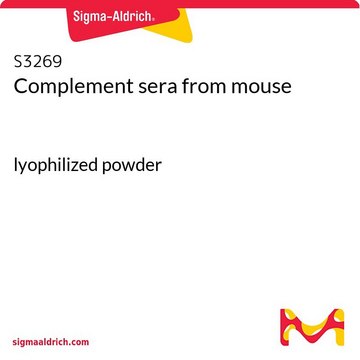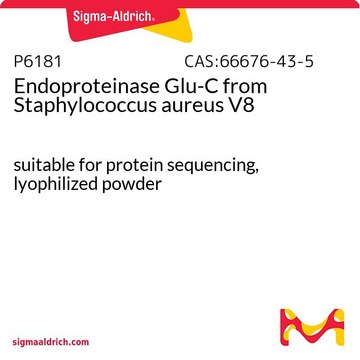C5233
Carboxypeptidase B aus meschlichem Pankreas
50-55 units/mg protein carboxypeptidase B
Synonym(e):
Peptidyl-L-Lysine[L-arginine] hydrolase
About This Item
Biologische Quelle
human pancreas
Qualitätsniveau
Form
solution
Spezifische Aktivität
50-55 units/mg protein carboxypeptidase B
Verunreinigungen
≤0.2% chymotrypsin
≤0.2% trypsin
≤1 unit/mg protein carboxypeptidase A
UniProt-Hinterlegungsnummer
Versandbedingung
dry ice
Lagertemp.
−20°C
InChI
1S/C31H38N4O7S/c1-20(32-26(36)15-16-27(37)38)28(39)33-21(2)30(41)35-17-9-14-25(35)29(40)34-24(18-22-10-5-3-6-11-22)31(42)43-19-23-12-7-4-8-13-23/h3-8,10-13,20-21,24-25H,9,14-19H2,1-2H3,(H,32,36)(H,33,39)(H,34,40)(H,37,38)
InChIKey
TWURVFFNODFJBJ-UHFFFAOYSA-N
Angaben zum Gen
human ... CPB1(1360)
Allgemeine Beschreibung
Anwendung
Biochem./physiol. Wirkung
Einheitendefinition
Physikalische Form
Lagerklassenschlüssel
12 - Non Combustible Liquids
WGK
WGK 1
Flammpunkt (°F)
Not applicable
Flammpunkt (°C)
Not applicable
Analysenzertifikate (COA)
Suchen Sie nach Analysenzertifikate (COA), indem Sie die Lot-/Chargennummer des Produkts eingeben. Lot- und Chargennummern sind auf dem Produktetikett hinter den Wörtern ‘Lot’ oder ‘Batch’ (Lot oder Charge) zu finden.
Besitzen Sie dieses Produkt bereits?
In der Dokumentenbibliothek finden Sie die Dokumentation zu den Produkten, die Sie kürzlich erworben haben.
Kunden haben sich ebenfalls angesehen
Unser Team von Wissenschaftlern verfügt über Erfahrung in allen Forschungsbereichen einschließlich Life Science, Materialwissenschaften, chemischer Synthese, Chromatographie, Analytik und vielen mehr..
Setzen Sie sich mit dem technischen Dienst in Verbindung.
